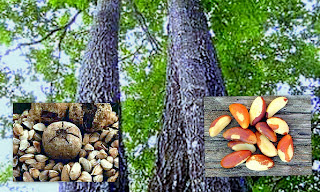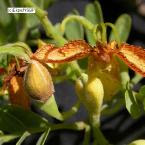This section describes the main characteristics of non-timber plant products of this huge store that is the Amazon, collected by traditional forest communities, indicating in each of these reference and summary of use and destination. I hope you find it interesting ride.
Acrocomia spp. Palmae (Arecaceae)
Palmera medium large in size between
Oil extracted from the ripe seeds are eaten by humans and livestock.
Aniba duckei A. Lauraceae rosaeo-dora
medium-sized tree
Wood and leaves are rich in linalool (essential oil) used in perfumery.
Palmera
Food for humans and pets and wild (fruit), thatched roofs, oil, fiber for hammocks nets and other artisanal products
Attalea speciosa (syn. Orbignya phalerata) Palmae ( Arecaceae)
Palmera
large-scale exploitation of the fruits (oil, soap. charcoal), food for human dominant component in some areas of forest fallow, handicrafts (baskets) thatched roofs; I think.
Bactris gasipaes Palmae (Arecaceae)
Palmera
large, rarely found in nature, usually planted by hunger
Food for human consumption (fruit, palm) oil, pet food and wild (fruit young leaves) .
Bertholletia Lecythidaceae
Large tree, recent
Food for humans and domestic animals and wildlife.
Carapa guianensis Meliaceae
Medium to large tree
Oil extracted from seeds that are used primarily as medicinal ointment but also for making soap.
Caryocar villosum Caryocaraceae
Large tree edible nuts are harvested from wild trees; mesocarp used locally as a substitute for butter.
Caryodendron spp. Euphorbiaceae
Large tree
human food (nuts oil) and domestic and wild animals.
Copaifera spp. Leguminosae
Large tree
The oily resin extracted from the tree without killing it has a stable market in Brazil as a medicinal product.
Couma spp. Apocynaceae
large and small trees
Frutos for humans and wildlife; latex to make chewing gum and plug cracks canoes.
Derris spp toxicaria Clathrotopis Lonchocarpus spp Tephrosia spp. Leguminosae shrub climbing vine
With roots developed ichthyotoxic substances are produced when fishing, some of these species are removed rotenone (an insecticide).
Palmera climbing
arrowheads fixation for artisanal products, can substitute for rattan.
Large tree extracted from the seeds coumarin (tonka beans), used in perfumery .
Large tree
human food (fruit, fat extracted from the seed)
Euterpe oleracea Palmae (Arecacese)
tall and slender palm
22 different applications that include all parts of the plant.
precatoria Palmae (Arecacea)
tall and slender palm (land) dry)
Thatched roofs: food and nonalcoholic gotten for human consumption (fruits clapping) .
Climber
Used by forest dwellers to make handicrafts, rattan can substitute .
Ischnosiphon spp., Thalia spp. Maranthaceae
Climber Used by forests to manufacture handicraft products.
bataua Jessenia Palmae (Arecaceae)
large Palmera
Non-alcoholic beverages for human consumption: oil of the same quality olive oil, hunting equipment, products crafts (baskets)
Lecythidaceae pisonis Lecythis
Large tree edible nuts are eaten by bats, parrots and monkeys.
Palmae Mauritia flexuosa (Arecaceae)
large Palmera
Food and beverages for human consumption (young flowers fruit), palm starch extracted from the stem, thatched roofs, sugar (crystallized sap) crafts.
Oenacarpus spp. Palmae (Arecaceae )
Palmera large and small
Non-alcoholic beverages, rich in vitamins, extracted from fruits, oil .
Paullinia cupana var. Sapindaceae sorbilis
Trapadora shrub seeds produced
used as a stimulant.
Protium spp. Burseraceae
medium to large tree
resin (elemi) extracted from the bark and used to caulk canoes, fruits that attract wild birds and bees.
Sterculiaceae Theobroma cacao tree
small fruit (pulp) that serves as food for humans and wild animals, seeds used by the inhabitants of the forest to make chocolate liquor sweet
Theobroma grandiflorum Sterculiaceae
Tree between medium and large
These traditional uses Theobroma cacao.



























0 comments:
Post a Comment